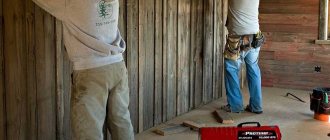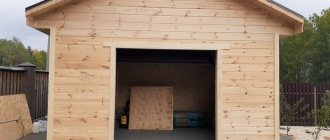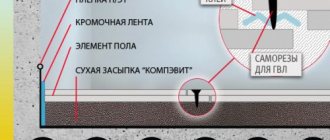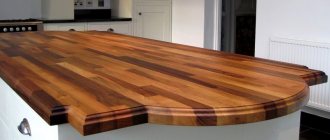Carefully! Electric current | 01/13/2020
The simplest scheme for splitting logs into logs is the one in which the splitting wedge makes a direct movement, parallel to the vertical axis of the log. However, this scheme is not the only one; moreover, it is ineffective if the wood fibers are twisted. In such situations, a screw wood splitter will help out.
Advantages and disadvantages of using a wood splitter
Before making any unit with your own hands, you should ask yourself whether it is necessary on the farm. Buying or making a device yourself will require a lot of financial costs and effort; you need to weigh all the advantages and disadvantages. The advantages of the device include:
- Physical activity on a person. The machine operator only loads and controls the process; the main physical work is performed by the wood splitter mechanism.
- A device that includes an electric drive will cope with the tasks faster than doing the work manually.
- Convenient use preserves health and physical strength.
- Ease of operation and the absence of the use of physical force make it possible for all types of people to use the mechanism.
Application of a wood splitter
There are noticeably fewer disadvantages during operation, but they are still present, as with every device.
- Complex design of some models. For a more uniform log, the final result is a hydraulic splitter. Making such a mechanism at home with your own hands is expensive and will take a lot of time.
- High cost of finished structures. Buying a ready-made wood splitter will save time on manufacturing, but the cost of some models is so high that it does not justify itself during use.
It is necessary to understand that for a small area purchasing equipment is not advisable. Having a clear purpose and constant sale of firewood, you should think about buying or making your own wood splitter.
Do-it-yourself screw wood splitter
Making a homemade screw wood splitter for a home craftsman will not be particularly difficult. The classic device diagram includes:
- A frame welded from a channel or rectangular pipe.
- Electric motor with a power of 2.0...2.5 kW with a speed of at least 1500 min-1. A gasoline engine with the same parameters is also suitable; in this case, the screw wood splitter will receive the mobility that is so necessary in field conditions.
- Reduction gearbox (taking into account the pulley that transmits torque to the shaft, its gear ratio should be within 1:3).
- A shaft rotating in roller bearings, with a seat for a screw cleaver (you can use a spindle from a powerful drill or screwdriver).
- The actual executive tool is a wedge on which a conical thread must be cut. Restrictions on wedge sizes are given in the previous subsection.
- Mechanism for feeding the workpiece to the wedge. A regular worm gear or screw-nut gear will do. A particularly advanced option is the installation of an intermediate shaft for power take-off on the feed drive, then the engine power will increase by 20...25%.
- The protective device is a rigid steel mesh that will protect the operator’s hands and face from possible injuries (the reader also already knows about this).
- A control panel, which can include two buttons - starting the engine and turning on the feed drive (you can add a third one, designed for emergency shutdown).
During installation, special attention should be paid to the parallelism of the support plate under the engine and the feed drive shaft, since the slightest misalignment will cause the screw wood splitter to fail.
Screw (cone-shaped) machine
A common model for harvesting firewood in small volumes is a machine with a conical cleaver, which can be additionally threaded, and is driven by an electric or gasoline engine. Such a device splits lumps due to a rotating cone, tearing the wood, and mechanical pressure exerted on the workpiece by a person.
You can buy the cutting part or grind it yourself if you have lathe skills. Remember that the presence of a thread will make it easier for you to work with a wood splitter, so it is advisable to cut it (we recommend left-hand cutting). Thread depth 2−3 mm, pitch 6−7 mm. The nose of the cone should be sharp. The landing site on the gearbox must have a depth of at least 70 mm.
The engine must have a power of 1.5-2 kW, voltage - from 380 V. The number of revolutions is 250-500 per minute, the speed below 250 rpm will greatly slow down the process of collecting firewood, and above 500 rpm there is a danger of the logs being pulled out of your hands . If you have an engine with a given number of revolutions, you can put a “carrot” on the crankshaft. If the revolutions go off scale, you will have to install a reduction gearbox or make a belt or chain drive to reduce the rotation speed.
The bed is the table on which the logs will be placed. It is made either from sheet steel or from thick wooden boards; the legs for it must be metal 40 cm long.
The distance from the table to the cleaver is 8-20 cm; if you increase it, there is a danger of turning over small-diameter logs. Installation of the log is vertical, otherwise the tree will get stuck between the “carrot” and the table and, most likely, bend the shaft. The workpieces should be no longer than 0.5 m and not exceed a diameter of 0.6 m. For this wood splitter, do not take tree species with intertwined fibers (birch, oak, etc.). For safe operation, place the cover over the motor and chain (belt).
DIY hydraulic wood splitter
This is not the simplest or cheapest, but it is quite powerful and very productive, almost eliminating manual labor when chopping wood. All you need to do is install the logs on the platform and collect the finished firewood in the woodpile.
This scheme uses completely ready-made components - oil tank and pump, motor, hydraulic cylinder, blade. Only the frame with the pusher is manufactured independently.
In a more detailed diagram, you can clearly see where the weakest point of the product is - where the cylinder stop is located
It is here that a poorly welded stop along with the cylinder is most likely to be torn off the frame, so the seams in this place should be treated with maximum attention
This is what the finished model might look like.
As you can see from the photo, the knife in this case is made of springs, sharpened at an angle of approximately 60 degrees. The pusher is welded from metal plates 5...10 mm thick, the frame is assembled from an angle and a channel. You will have to select the necessary rolled metal products yourself, based on the available reserves.
The main parts and components of the device are presented in the assembly diagram.
Here:
- bed;
- cleaver (knife);
- wheels (optional, if necessary, periodically move the machine);
- a carriage pushing the block onto the knife;
- hydraulic cylinder;
- hydraulic type distributor with a lever, it operates the machine;
- hydraulic pump (model NSh-32);
- tank for filling liquid (oil), volume 32 l;
- hydraulic pump drive shaft with cardan;
- drive shaft housing;
- electric motor (model AIR80V2);
- turntable;
- drive pulley;
- driven pulley;
- drive belt.
This is what the bed may look like in this model.
Carriage assembly.
Turning platform.
Transmission mechanism.
The device is assembled.
This video describes how to make a homemade hydraulic wood splitter.
Product Features
A wood splitter is always useful on the farm; you can either buy it ready-made or make it yourself using available materials. Ready-made options have been improved; there are a number of additional functions that allow you to chop maximum firewood in a short time.
There are many installations operating in an automated format. This is good, because you can not waste time on work, but start a machine that will do everything itself. Experts identify several characteristics that can be used to classify mechanisms into categories:
- Depending on the method of stacking logs, machines can be vertical or horizontal. Sheer structures are considered more powerful and durable, since they can process even a thick deck in a short period of time. If the logs are crooked or have many irregularities, then it is better to give preference to the horizontal mechanism.
- Maximum amount of stacked firewood. Depending on this criterion, equipment can be divided into equipment for home use and for industrial use.
- Drive types. For home use, a machine with a low power electric type is suitable.
In this video we will look at a hydraulic wood splitter:
Features of screw wood splitters
Given the complexity of the trajectory of movement of a mechanized splitting wedge, some advantages are also achieved:
- Speed. When encountering knots or knots of wood fibers, the screw wedge will deal with them faster, since with such a movement the axial force is divided into two components - vertical and horizontal. If one fails, the other will work.
- Insensitive to the location of the original workpiece - it can have both a vertical and horizontal position. This is convenient if it is not possible to allocate sufficient space to the screw log splitter.
- Quality of separation. A forward-moving wedge will get stuck in hard wood, which (when using any type of drive) will lead to overload of the motor in terms of torque.
There are also disadvantages, the main one of which is the increased danger of use: it is enough to get caught on the wedge with a small piece of clothing - and serious injury is guaranteed. At the same time, it is very problematic to reduce the level of danger, except perhaps by installing a mesh fence around the processing area.
Carefulness in the initial installation of the screw wedge is also essential - if it is done even at a slight angle, the tool will break.
The simplest DIY wood splitter
cone wood splittersmetal cone with thread
In cases where it is not possible to order or make a cone on a machine, this part can be made with your own hands using a grinder. At the same time, there is no need to strictly maintain precise dimensions. In this case, you just need to first place the grinder on the electric motor pulley and evenly cut the metal, ensuring its free rotation.
The finished cone is put on a shaft with bearings of the required size, where at the end there is a flange with an asterisk from a scooter wheel. The threaded cone is attached to the shaft using a bolt or pin, this makes it possible to easily remove it from the shaft and unscrew it from the block when jammed.
A removed cone that is wedged in a log can be easily unscrewed from the wood using a gas wrench. If the cone is firmly fixed on the shaft, then, when jammed, it becomes necessary to remove the drive chain, since the motor shaft cannot always be turned in a different direction.
https://youtube.com/watch?v=qG_v8ZBSoVY
Manufacturing Features
The operating method of this screw log splitter is very simple. During rotation, the cone, like a self-tapping screw, is screwed into the log, splitting it. When working with a wood splitter, you need to be extremely careful and follow safety rules.
Types of wood splitters
Household devices only have the function of splitting logs. Professional devices have a very complex design that feeds wood, trims to a given length, splits and ejects chopped wood. Naturally, the price, performance, and power of these devices cannot be compared with conventional factory-made wood splitters, and even more so with your own hands.
According to the device for feeding split wood, wood splitters can be vertical, horizontal and combined.
In horizontal devices, the block of wood is mounted on a horizontal gutter. Moreover, taking into account the design, either the pusher moves the log towards the stabbing knife, or the knife moves along the guide towards the log.
In vertical wood splitters, the log is fed vertically, and a moving knife on top splits it. The mechanisms of this design are the most productive, they do not occupy such a large area, but they also have their disadvantages. So, during the operation of vertical wood splitters, you need to support the splitting logs with your own hands, which requires strict adherence to safety precautions.
Combined type devices combine the capabilities of the devices described above and are used only in woodworking factories.
Considering the power source, wood splitters are divided into the following types:
- Tractor-powered devices. Such devices are connected to the tractor hydraulic system with a powerful take-off shaft. These are professional and powerful devices that are designed to work in large industrial enterprises, forestry farms and complexes.
- Wood splitters with diesel or gasoline engines. These are very powerful devices that are used, as a rule, in logging. However, they are also suitable for work in country houses.
- Combined devices. Some models have electric motors or internal combustion engines, and are also adapted to operate from a tractor shaft.
- Wood splitters with electric motors. These are the simplest designs of wood splitters. The electric motor activates the hydraulic pump. These units are easy to operate and maintain and can be installed in almost any room.
Wood splitters with electric motors do not require much maintenance and are best suited for home use. The only prerequisite for their operation is the availability of electricity.
Taking into account the design of the log splitting mechanism, wood splitters are divided into the following types:
- Cone or screw (we just told you above how to make this wood splitter with your own hands). In these devices, the role of a knife is played by a threaded cone; it splits the log by screwing into it. Using this operating principle, you can completely make a wood splitter with your own hands, because it is quite simple and does not require the manufacture of additional mechanisms. But, for its productive operation, a powerful electric motor is required.
- With hydraulic drive. At the heart of these devices is a hydraulic pump, which drives a splitting knife; it, pressing with great force on the log, splits it.
Also, industrial devices differ in the method of transportation. Most often, heavy and large devices are made in a stationary version. But the design of lightweight devices includes wheels, which make them easy to move.
Which engine to choose for a wood splitter?
Complete gasification of the entire territory of Russia has not yet occurred. Therefore, a significant part of the inhabitants of the country, which has a rather harsh climate, have to heat their homes with wood the old fashioned way.
The problem is that daily exercises with a cleaver or an ax do not cause much enthusiasm among Russians. Therefore, more and more often, home-made and “factory” wood splitters are appearing in the households of modern homeowners, which significantly simplify preparation for the heating season, as they are capable of preparing a large amount of fuel material in a short time.
The design and principle of operation of such devices, which are manual, mechanical and hydraulic, can vary significantly. However, the scheme of work is completely the same:
- a wooden block is placed automatically or manually in the feed chute between the knives and the movable piston;
- the piston pushes the workpiece onto the knives, which split it into several logs.
Let's leave aside the manual version and hydraulics, since in everyday life a mechanical design with an electric or gasoline engine is most often used, which has certain requirements for power and output speed.
The thing is that low-power devices simply cannot cope with chopping firewood, especially hardwood and raw wood.
Therefore, when purchasing a factory device or assembling a homemade product, you should pay special attention to the motor power of at least 2.2 kW.
The dependence here is as follows - the greater the motor power, the higher the operating pressure (measured in tons), which allows the device to split the most “complex” logs. In practice it looks like this:
- When working with poplar, aspen and other “soft” woods, a wood splitter with a working pressure of up to 5 tons will be sufficient.
- A similar parameter for units capable of splitting oak, pear and other hard wood into firewood should be between 5 and 7 tons.
- Only installations that have a working pressure of more than 7 tons can handle wet wood and particularly hard stumps.
The second important characteristic when choosing a unit for chopping wood is the engine speed, which should be in the range from 300 to 1000 rpm. Therefore, high-speed engines in such devices are necessarily equipped with reduction gearboxes.
It remains to figure out the type of engine. Electric motors are more suitable for stationary installations at home (220V) and in production (380V). The gasoline version is better suited for mobile installations, as it has greater autonomy.
Hit or push?
Splitting wood chips is considered a dangerous production process: a blank that turns out of the machine can flatten a person, and flying wood chips can pierce him through. It is impossible to completely exclude emergency situations when chopping wild wood - in this regard, it is far from a completely predictable material. As a result, some types of technical classification of devices for splitting raw wood need to be kept in mind in order to make a wood splitter that is safe enough for everyday use. Namely, whether it is a shock action or a pressure action:
- Mechanized impact splitters with intermediate energy storage are highly efficient, economical, and almost completely relieve the operator of muscular effort, but they are structurally complex and the most dangerous in operation. They cope with any kind of fools, incl. with butt ridges of elm and larch.
- The same, manual ones without a mechanical energy accumulator - non-volatile, cheap, and structurally simple. They can be used in pressure mode and thus split twisted and knotted wood up to 25-30 cm in length. They require less muscular effort, and work safety is higher than when manually chopping with a cleaver on a block. Low productivity; suitable for irregular and occasional preparation of firewood.
- Push splitters driven by an internal combustion engine or an electric motor are quite expensive (see below). Also, the muscular efforts of the operator are almost completely eliminated. The productivity is sufficient to regularly supply firewood to a house of up to 200-300 sq. m in winter with frosts down to –40 and below. The highest possible security is achievable for this class of devices. Disadvantages are the complexity of the design and fairly high energy consumption in the form of electricity or liquid fuel.
Why - don't hit
In mechanical impact wood splitters, a relatively weak engine spins the flywheel through a fluid coupling. Thus, the engine operates almost all the time at optimal speed and consumes a minimum of fuel/electricity. Then a crank with a pusher is engaged with the flywheel (hydraulic or frictional), feeding the block to the splitting knife. The impact force is colossal: more energy can be “pumped” into a flywheel with a diameter of 60-80 cm than in a 100 kg aerial bomb. Churak actually does not split, but is cut with a knife, despite any defects in the wood.
Abroad, where energy resources and high-quality straight-layer wood are expensive, household mechanical impact wood splitters are produced and are in demand, see photo at the beginning. There are no imports of such devices into the Russian Federation, and industrial ones are finalizing their resources and analogues to replace them are not being developed. The reason is that they are extremely dangerous. Modern composite superflywheels do not burst, but it is impossible to stop the push from the flywheel and thereby prevent the development of an emergency situation into a threatening and dangerous one. Therefore, further in the article mechanical impact wood splitters with energy storage are not considered.











